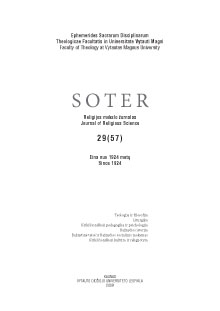Romuviečių pasaulėžiūrinės grupės genezė (1919–1923 m.)
GENESIS OF ROMUVA ADHERENTS’ WORLD-VIEW GROUP (1919-1923)
Author(s): Ramūnas LabanauskasSubject(s): Christian Theology and Religion
Published by: Vytauto Didžiojo Universitetas
Keywords: atviroji katalikybė; genezė; jaunieji katalikai; ideologija; katalikai kultūrininkai; katalikybė; krikščioniškoji demokratija; pasaulėžiūrinė grupė; romuviečiai; tautiškumas; open Catholicism; genesis; young Catholics; ideology; Catholics; cultural figure
Summary/Abstract: Catholicism is observed as interaction of two branches of Catholicism: traditional and public. The distinguishing line between them is a relation with Church teaching and Magisterium formulating and keeping it. The selective recognition of traditional Church teaching (and observance of it) and partial obedience to Magisterium formulating and keeping the Church teaching define Public Catholicism. In Church history public Catholicism was observed in various forms starting from Gnosticism, medieval heresies, the Reformation and finally, with modernism at the beginning of 20th century or aggiornamento by John XXIII. The dualism of Catholicism is acknowledged in non-fiction literature, too. Both forms of Catholicism are based on Credo formulated in early Church and common-human experience and mind (science). But the relation with Credo based on unquestionable statements becomes problematic for both forms of Catholicism: traditional catholicity inclines to eliminate common-human experience, whereas public Catholicism plunges into credenda’s reinterpretation which endangers Catholicism. Lithuanian Catholic society’s world-view spread at the beginning of the 20th century was determinated by national revival movement which brought forward nationality with regard to Catholicism (and neo-orthodox character of interwar Catholicism was determined by that) and by Christian democracy. The formation of the camp of Catholic cultural figures was influenced by the beginning of the 20th century’s approaching tendency of science (culture) and religion and new neo-orthodox religion concepts of Western Europe’s and Russia’s intellectual life: the movement of the Catholic revival (Renouveau catholique) in France, cultural Catholicism and especially liturgical movement conveyed in youth movements propagated complete life in Germany. The renewal was inspired by neo-Thomism, too. Lithuanians got to know it at Catholic universities of Fribourg and Leuven. The Catholic cultural figures were significantly influenced by “a new religion consciousness” settled in Russian Orthodoxy. The formation of Catholic cultural figurers was opposed by the radicalism of Christian democrats who had the ambition to become the only representatives of Catholic society. Some world-view trends (which can assume more exact world-view group or more unlimited format of tendency) can be marked in the place of Catholic cultural figures: national (it was represented by world-view group of Romuva adherents), social (represented by the prelate Kuraitis), Catholic moves (represented by the so-called progressive bishops) and conservative-religious trend found in the periphery (represented by P. Dovydaitis). All these trends were banded together by social, publicly engaged ideal of Catholicism. Šalkauskis’ messianic disposition, Pakštas’ national engagement and Eretas’ relations with the Catholicism, especially scholasticism, were the main factors which determined the formation of the Romuva adherents’ w
Journal: SOTER: religijos mokslo žurnalas
- Issue Year: 57/2009
- Issue No: 29
- Page Range: 121-140
- Page Count: 20
- Language: Lithuanian

